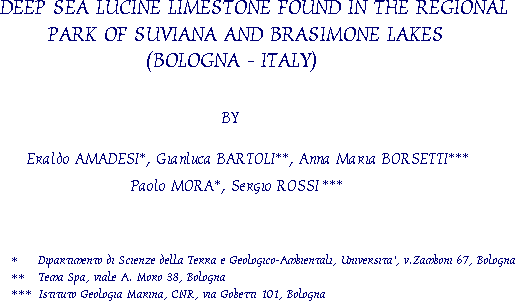

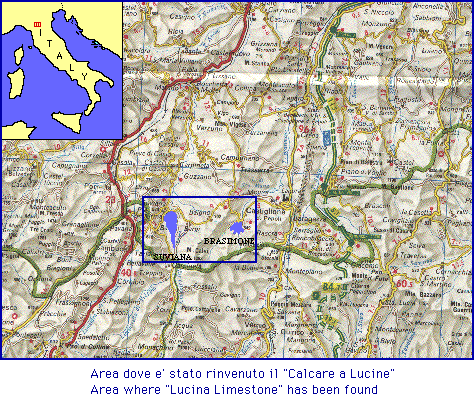


INTRODUCTION
The regional Park of Suviana and Brasimone Lakes is extended for about 3500 ha in the area of Camugnano and Castel di Casio Villages, both in the Province of Bologna. The area is comprised between the northern margin of the Apennine belt and the top of the hills that mark the boundary with the Tuscany Region.
From a morphological point of view it is characterized by the two artificial lakes, by the deep valleys of the Limenta di Treppio torrent on the west and the Brasimone torrent on the east, as well as the relief created by the M. Calvi, M. di Stagno and Alpe. In the region of M. Calvi. There are two kinds of glacial erosion representing small glacial circus.
The Apenninic area is densely wooded with beech-wood present above 800-900 m. Chestnut-wood occurs between 800 and 600 m while oak-wood occurs at lower elevations. The coniferous groves are anywhere.
On the contrary, in the area of the Park, at the foot of the chain widespread the cultivations and uncultivated lands.
GEOLOGY
Three are the main units which characterise the area: M. "Cervarola Formation", "Ponte della Venturina" allochthonous unit and the similar "Argille Scagliose".
The first one forms the Apennines ridge represented by a marl-arenaceous flysch with a varying ratio between sandstone/marl (usually <1), with well developed groove-flute casts and with well visible gradation of bed-rocks. This unit forms an anticline fold overturned to North, E-W oriented and with the axis passing by "Poggio delle Vecchiette" and M. "di Stagno".
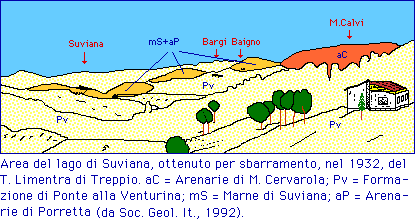
The two other units represent two separate allochthonous nappes which in different times overlay the M. Cervarola Formation, forming thick thickness in the zones of actual outcrops, very probably a lower structure area.
The "Ponte della Venturina" nappe, partly involved in the folding and overturning of M. Cervarola flysch, appears in a narrow strip along the Apennines slope foot.
The "Argille Scagliose" nappe appears immediately toward North.
The clay-marl lithology of these two nappes warrants the impermeability and therefore the seal of the Brasimone and Suviana lakes.
LUCINA LEVEL
In the overturned leg of the Poggio delle Vecchiette - M. di Stagno anticline, it was found an interesting calcareous interbed with a rich micro and macrofauna. This interbed bank is represented by a dark-grey limestone with a light tone on the altered surfaces and with thickness swinging between 40-50 cm and 2 m (Bartoli, 1994).
The high density of the vegetation coverage and the sharp morphology, made hard the exact location of outcrops with the presence of Lucina. Therefore it was necessary to make a GPS (Global Positioning System) relief completed by usual topographic measures.
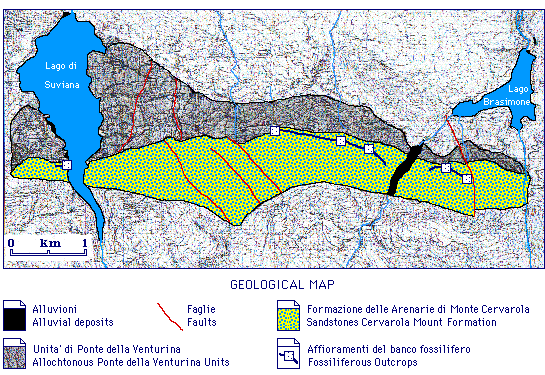
The fossiliferous bank, named "Lucina level", stands out at an altitude between 800-1000 m and it was followed for about 4 Km. Other lonely outcrops, but well related to the former, were found in a second time outside the Park's area, both toward East and toward West.
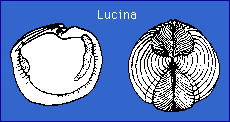
The macrofossils Lucina show dimensions of 4-6 cm. They are Mollusks Lamellibranchia Heterodonts, characterised by a rounded lenticular shell. Their hinge presents two cardinal teeth and two lateral teeth, all well developed. The shell decoration is poor and it's formed by concentric strips.
These macrofossils are concentrated into nests and therefore they don't appear in all the outcrops, but it's the microfauna the main characteristic parameter. In fact this last one is constant both as association type and as abundance. This microfauna is represented by planktonic and benthonic Foraminifera. Then there are remains of Crustaceans, Echinoideans and Fishes.
For the age determination of the "Lucina level" and therefore of the upper part of the M. Cervarola Formation were more useful planktonic Foraminifera with the following species: Globigerinoides trilobus, Globigerinoides bisphericus, Globorotalia ex gr. scitula, Globoquadrina dehiscens, Orbulina suturalis, Praeorbulina glomerosa. This association, from the stratigraphic point of view, corresponds to the more recent part of the zone N9 of Blow (Blow, 1969) and to the upper part of the stratotype of the Langhian (Middle Miocene, 16.4 - 14.8 ma).
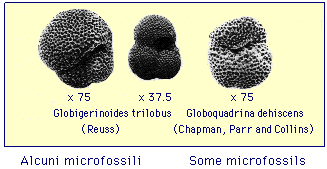
The brown- ochraceous colour that characterises the thin sections is very probably due to the presence of organic material and phosphates.
The abundance and the differentiation of planktonic Foraminifera show an environment of deep waters; the presence of few Globorotalia ex gr. Scitula testifies cold-temperate water. The good preservation of Fishes and Crustaceans remains permits to establish a lower Oxygen content.
The scene is very similar to the one of the fossil fauna due to cold methanogenetic events, already described by Taviani (Taviani, 1984) in a more recent range (Tortonian, Upper Miocene) and belonging to the "Marnoso-Arenacea" Formation.
For all these reasons, the Lucina seem to be revealers of methanogenetic events from underground.
Bibliography

First opening site: 1998-11-25
Powered by
Sergio Rossi ed.

Go home |

E-mail me







